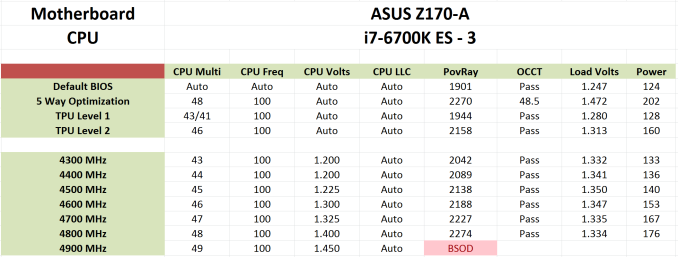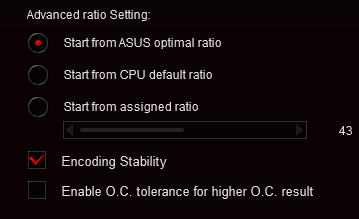The Intel Skylake i7-6700K Overclocking Performance Mini-Test to 4.8 GHz
by Ian Cutress on August 28, 2015 2:30 PM ESTFrequency Scaling
Below is an example of our results from overclock testing in a table that we publish in with both processor and motherboard. Our tests involve setting a multiplier and a frequency, some stress tests, and either raising the multiplier if successful or increasing the voltage at the point of failure/a blue screen. This methodology has worked well as a quick and dirty method to determine frequency, though lacks the subtly that seasoned overclockers might turn to in order to improve performance.
This was done on our ASUS Z170-A sample while it was being tested for review. When we applied ASUS's automatic overclock software tool, Auto-OC, it finalized an overclock at 4.8 GHz. This was higher than what we had seen with the same processor previously (even with the same cooler), so in true fashion I was skeptical as ASUS Auto-OC has been rather hopeful in the past. But it sailed through our standard stability tests easily, without reducing in overclocking once, meaning that it was not overheating by any means. As a result, I applied our short-form CPU tests in a recently developed automated script as an extra measure of stability.
These tests run in order of time taken, so last up was Handbrake converting a low quality film followed by a high quality 4K60 film. In low quality mode, all was golden. At 4K60, the system blue screened. I triple-checked with the same settings to confirm it wasn’t going through, and three blue screens makes a strike out. But therein is a funny thing – while this configuration was stable with our regular mixed-AVX test, the large-frame Handbrake conversion made it fall over.
So as part of this testing, from 4.2 GHz to 4.8 GHz, I ran our short-form CPU tests over and above the regular stability tests. These form the basis of the results in this mini-test. Lo and behold, it failed at 4.6 GHz as well in similar fashion – AVX in OCCT OK, but HandBrake large frame not so much. I looped back with ASUS about this, and they confirmed they had seen similar behavior specifically with HandBrake as well.
Users and CPU manufacturers tend to view stability in one of two ways. The basic way is as a pure binary yes/no. If the CPU ever fails in any circumstance, it is a no. When you buy a processor from Intel or AMD, that rated frequency is in the yes column (if it is cooled appropriately). This is why some processors seem to overclock like crazy from a low base frequency – because at that frequency, they are confirmed as working 100%. A number of users, particularly those who enjoy strangling a poor processor with Prime95 FFT torture tests for weeks on end, also take on this view. A pure binary yes/no is also hard for us to test in a time limited review cycle.
The other way of approaching stability is the sliding scale. At some point, the system is ‘stable enough’ for all intents and purposes. This is the situation we have here with Skylake – if you never go within 10 feet of HandBrake but enjoy gaming with a side of YouTube and/or streaming, or perhaps need to convert a few dozen images into a 3D model then the system is stable.
To that end, ASUS is implementing a new feature in its automatic overclocking tool. Along with the list of stress test and OC options, an additional checkbox for HandBrake style data paths has been added. This will mean that a system needs more voltage to cope, or will top out somewhere else. But the sliding scale has spoken.
Incidentally at IDF I spoke to Tom Vaughn, VP of MultiCoreWare (who develops the open source x265 HEVC video encoder and accompanying GUI interface). We discussed video transcoding, and I bought up this issue on Skylake. He stated that the issue was well known by MultiCoreWare for overclocked systems. Despite the prevalance of AVX testing software, x265 encoding with the right algorithms will push parts of the CPU beyond all others, and with large frames it can require large amounts of memory to be pushed around the caches at the same time, offering further permutations of stability. We also spoke about expanding our x265 tests, covering best case/worst case scenarios from a variety of file formats and sources, in an effort to pinpoint where stability can be a factor as well as overall performance. These might be integrated into future overclocking tests, so stay tuned.












103 Comments
View All Comments
Oxford Guy - Sunday, August 30, 2015 - link
Who is the one trolling?SanX - Saturday, August 29, 2015 - link
If Intel by moving to 14nm (with its potentially twice smaller surface area versus 22nm) made mainstream octacores overclockable like 4770k/4790k i'd be interested. Otherwise it is hard to see any progress at all. Shame, even cellphones are octacores.Oxford Guy - Sunday, August 30, 2015 - link
You can get AMD FX to run at over 4.5 GHz with generally only decent cooling. As for seeing progress, overclocking may be less and less viable as process nodes shrink.Oxford Guy - Sunday, August 30, 2015 - link
We seem to be seeing this borne out in the review, too. Voltages remain too high. Then, when that fails to do the trick, reviewers try to claim that unstable settings are good enough.stephenbrooks - Sunday, August 30, 2015 - link
I wonder how much of this is choice of the "optimum" frequency for the process? I think Intel only has two processes per node, a standard and a low-voltage/low-power one. If the standard one has been stretched to pretty low powers (10W?), the top end suffers from high voltages because it's not optimal there. They'd end up having to commission a 3rd "high frequency" process to get these top end chips right. There's no incentive until they have a real competitor there, but at this glacial rate of progress perhaps AMD really will catch up in a few years.SanX - Saturday, August 29, 2015 - link
Isn't true reason behind this zero progress that having no competition at all, Intel wants us to pay $3-4K for octacore chip which probably costs just $100-200 to produceMrSpadge - Thursday, September 3, 2015 - link
Of course they'd want us to pay 3-4k$ for an octacore, but they don't expect us to do so. That's why they sell it for 1k$.IUU - Sunday, August 30, 2015 - link
So, obviously it is not worth the benefit and the risk you take, to overclock it. Which is somewhat understandable. Overclocking it as a hobby is always nice, naturally.Of course, a progress would be to be able to overclock to 5.5Ghz, especially as 4.8 - 5.0 Ghz have been achieved already since several years. But you can't force nature.
On the other hand, I am just curious about the theoretical fp performace and the impact of the new instruction sets on it. The fact that the market chooses to ignore them, does not negate the potential of these processors.
And also curious as to how able they are to run narrow ai apps, or multitasking several "heavy" apps. Sorry, but the fixation on office, "professional apps", and first person shooter(or moving camera) games doesn't cut it anymore.
Would you be so interested to see how quickly your pc plays pacman in 2000? This is something like it.
I, myself have witbessed the effect of new instruction sets up to haswell, on niche apps. And I have to say , impressive is an understatement. We are talking a 40% percent improvement clock for clock. I just hope programmers will be in a position to take advantage of this untapped potential some day.
Also, algorithmic optimizations do perform miracles. I have seen them increasing the performance on the same app and chip up to 50%, instructions sets excluded.
And finishing, often seeing sites examining the performance of theses chips on browsers, is in my opinion, the peak of the decadence.(no matter how many useless addons we added or how much clunky we made, unneccesarily, the code.)
callous - Sunday, August 30, 2015 - link
I don't think most people test properly their overclocks. You always need to run prim95 with some 3d component looping for at least 24 hours. prime95 stable does not mean 3d stable. Only testing both at the same time: prime95 + 4 instances of heaven benmark can you test most of the components inside the cpu at the same time while system is being stressed.I would go further and say if you can do this for 24 hours then you should run some VMware and see if there are bad things happening like bsod or weird crashes of programs running the background.
sonny73n - Sunday, August 30, 2015 - link
I got excited when I first saw the title of this article but I'm a little disappointed now after finished reading it.1.52v for only 4.8Ghz? Does 14nm need that much voltage? My 32nm 2500k only needs 1.42v for 48x. What about temp under load? Regardless what settings Handbrake uses or 4K60fps it encodes, if it didn't cause BSOD with CPU at stock speed but BSOD when CPU OCed, then OC isn't stable. Since you OC this chip with the 2 best OCing mobo brands, then it's the chip's fault. Why did you use HB for stability test? P95 for 6 hours would do. Beside, IBT is about 8C hotter than P95 but HB runs about 10C cooler than P95. HB is hardly a stress test.
I might've missed it but did you have power saving features disabled or enabled? If you let the MB auto OC, what are the settings?